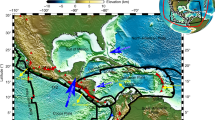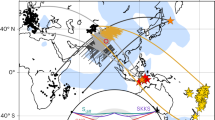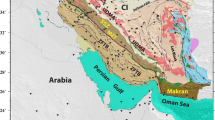Abstract
Asthenospheric mantle flow drives lithospheric plate motion and constitutes a relevant feature of Earth gateways. It most likely influences the spatial pattern of seismic velocity and deep electrical anisotropies. The Drake Passage is a main gateway in the global pattern of mantle flow. The separation of the South American and Antarctic plates since the Oligocene produced this oceanic and mantle gateway connecting the Pacific and Atlantic oceans. Here we analyze the deep crustal and upper mantle electrical anisotropy of its northern margin using long period magnetotelluric data from Tierra del Fuego (Argentina). The influence of the surrounding oceans was taken into account to constrain the mantle electrical conductivity features. 3D electrical models were calculated to fit 18 sites responses in this area. The phase tensor pattern for the longest periods reveals the existence of a well-defined NW-SE electrical conductivity anisotropy in the upper mantle. This anisotropy would result from the mantle flow related to the 30 to 6 Ma West Scotia spreading, constricted by the subducted slab orientation of the Pacific plate, rather than the later eastward mantle flow across the Drake Passage. Deep electrical anisotropy proves to be a key tool for a better understanding of mantle flow.
Similar content being viewed by others
Introduction
The Earth’s evolution is guided by continental drift, ultimately driven by mantle flows1. The understanding of mantle convection and hence, the geodynamic processes, strongly depends on the behaviour of the Lithosphere-Astenosphere boundary (LAB)2,3. The LAB has been estimated to rapidly increase in oceanic floors younger than 55 Ma and to be deeper or equal to 150 km in the transition between oceanic-continental lithosphere2. Whereas subduction zones represent major mantle flow barriers, areas of relatively weak continental lithosphere may connect different oceans along mantle gateways4. Mantle cells related to seafloor spreading represent a suitable process provoking mantle flow and the subsequent anisotropy orthogonal to the spreading axis. Thus, in recent structures without overprinted deformations, mantle fabric consistently fits paleo-spreading directions in oceanic basins5. Seismic anisotropy studies provide widespread results for a broad depth range, as well as more detailed data restricted to the mantle top6. In contrast, long period magnetotelluric (LMT) research allows for a comparatively high depth resolution of mantle electrical anisotropy7,8,9,10,11. Apart from mineralogical composition, laboratory studies reveal the temperature and pressure dependence of the electrical conductivity of the rocks. Additionally, water conditions, partial melt as well as oxygen or hydrogen fugacity influence the electrical features8. Several investigations have related crustal electrical conductivity with the presence of saline fluids or highly conductive minerals (eg; graphite, sulphides or Fe/Ti oxides)12,13,14. Whereas the electrical properties of the upper mantle are constrained to temperature dependence in case of dry olivine, partial melting or presence of water, the asthenopheric mantle electrical anisotropy is not accurately constricted. Given the homogeneity of asthenospheric mantle composition, the origin of its electrical conductivity and anisotropy is proposed to be a consequence of interstitial melts and/or the olivine elongation. Mantle flow determines the elongation of the olivine crystals which constrain the shape of interstitial space occupied by melts and hence the electrical anisotropy direction. The strain in olivine due to mantle flow favours pencil glide [1 0 0]-11,15,16,17. Hydrogen diffusion along these olivine elongation axis, explains the existence of preferential conductivity directions in context with a very low fraction of partial melt7,8,11,18. Electrical anisotropy has been used in a number of geological contexts to date7,8,9,10,11,14, but never with a focus on mantle gateways. The Drake Passage (Fig. 1) is a major mantle and oceanic gateway driving the global pattern of the Earth´s mantle flow19. It was formed since the Oligocene through the fragmentation of the prior continental connection between South America and the Antarctic Peninsula, and the subsequent development of the Scotia Arc19. The Arc itself is composed by the Scotia and Sandwich plates, in between the South American and Antarctic plates. Tierra del Fuego (South America), located in the continental lithospheric area at the northern branch of the Scotia Arc, is crossed by the South America-Scotia left-lateral transcurrent plate boundary. This area, at the northern margin of the mantle gateway, draws particular interest in terms of the effect of mantle flow. Petrological20 and geophysical data —including gravity research21— provide evidence supporting the inception of the Pacific mantle in the Atlantic during the development of the tectonic arc. However, other studies hold the absence of mantle flow from Pacific in this gateway in view of petrological data and the topography evolution of the Scotia Sea during the development of the Scotia Arc22,23. Anyway, the Scotia Arc deep structure is poorly known due to the scarce distribution of seismic stations located in its eastern and southern parts24,25.
Tectonic structure of the Scotia Arc. (a) Location of the studied area is marked by yellow square. (b) Map view including sites position (red triangles); FL, Fagnano Lake. Generated from GlobalMapper 17 http://www.bluemarblegeo.com/products/global-mapper.php and CorelDraw x8 https://www.coreldraw.com.
Methodology and Results
In 2012, a long period magnetotelluric (LMT) study with 18 stations distributed along two profiles was performed in Tierra del Fuego to investigate the deep crustal and upper mantle conductivity (Fig. 1b). The three magnetic and two telluric field components were recorded at a sampling rate of 4 Hz using a LEMI-417 system. Standard robust processing yielded high quality transfer functions. Figure 2a displays the pattern of the phase tensor and the real and imaginary part of the tipper vector for the periods 100 s, 1000 s and 6250 s at the field sites. In the shorter period (100 s), there is a smooth transition between the phase tensor for the northern and southern sites. Phases beneath 45° indicate an increase of resistivity with depth toward the north. Tipper orientations abruptly change for sites north and south of Fagnano Lake. With increasing period, tipper vectors reveal a homogeneous pattern rotating clockwise from pointing to NW at 1000 s (average −47° ± 17°) to almost pointing to N at 6250 s (average −8° ± 6°). It is noteworthy that the magnitude of the tippers decreases towards the North as the distance increase from the Drake Passage. Phase tensor values increase with period, with a remarkable homogeneous split of about 20° at 6250 s. Thereby the 45° principal axes take almost the same direction as the tipper vectors with 65° phases for the orthogonal axis. Thus, phase tensors reveal a NW-SE conductive direction at depth.
Phase tensor, real part (red) and imaginary part (blue) of tipper (Wiese convention) for all field sites. (a) Observations. (b) 3D bathymetry model. (c) 3D model considering bathymetry, the main geological units and an isotropic asthenosphere. (d) 3D model considering bathymetry, the main geological units and an anisotropic asthenosphere. Modeling results are compared for the periods 100 s, 1000 s and 6250 s. FL, Fagnano Lake. Structures details in Fig. 3.
The influence of seawater on MT parameters (phase tensor and tipper vectors) at coastal areas strongly depends on the bathymetry8,26,27. Finite element (FE) models26 (Comsol Multiphysics 5.2TM, http://www.COMSOL.com/) were calculated to investigate seawater influence on the MT results in the study area (Fig. 2b) in view of GEBCO bathymetry (www.gebco.net) with an average seawater resistivity of 0.25 Ωm. The depth of investigation (skin depth) depends on period and resistivity (δ = 500 √ρT) where δ has units of meters, T is the period in seconds and ρ is the electrical resistivity in Ωm28. Figure 3 covers the depth range found to be sensitive to our observations. The model size was frequency dependent and of the order of several skin depths with increasing mesh size from the center, thus providing sufficient resolution in the survey area and avoiding boundary effects. About 300.000 mesh elements roughly yielded 4 million degrees of freedom. A preliminary conductivity model reflects the main geological units, i.e. the conductive basins and the resistive lithosphere (Fig. 3). Furthermore, the influence of an isotropic (Fig. 2c) and an anisotropic (Fig. 2d) asthenosphere was considered. It is obvious that toward the end of the long period the conducting isotropic asthenosphere reduces the length of the tipper vectors considerably, while the phase split does not appear, either with or without asthenosphere. Additionally, the observed tipper vectors are rotated anti-clockwise by roughly 30° on average. We found that an anisotropic asthenosphere with a resistive principal axis in a N60°E direction (resp. the conductive principal axis in N150°E direction) explains both the large observed tipper vectors and the phase split along the two profiles (Fig. 2d).
Discussion
In summary, the bathymetry crucially influences the behavior of MT response functions at sites onshore. It is essential to account for bathymetry in any MT study in the Tierra del Fuego region. The implementation of an azimuthally anisotropic upper mantle improves the data fit significantly. The high conducting principle axis describes the assumed direction of mantle flow, confirming the importance of electrical mantle signatures reported in MT investigations. The main results of MT research in Tierra del Fuego reveal the existence of a main NW-SE oriented anisotropy in the upper mantle. Alternative models may be proposed to explain the mantle anisotropy in the northern Scotia Arc. We might consider former mantle anisotropies parallel to the Andes Cordillera, which has a general N-S trend along the South American continental margin and is arched up to an E-W trend in the southernmost part of the continent. However, such behavior would produce an ESE-WNW to E-W anisotropy parallel to the strike of the main geological structures, which is oblique to the N150°E conductive direction obtained in the region. Given this setting, we favor that the anisotropy may be related to the NW-SE oceanic spreading of the West Scotia Ridge (Fig. 4), active from 30 to 6 Ma29. Since the continental crustal rifting, the Drake Passage opening was driven by mantle flow linked to this oceanic spreading axis. Peridotite strain may evidence features of mantle flow that can be actual or remained. Nowadays, the anisotropy beneath Tierra del Fuego corresponds to the last strong flow recorded in that sector. Since the West Scotia Ridge was inactive, mantle flow was probably forced below the continental margin and confined to the west by the active Pacific subducted slab that may act as a barrier, blocking any mantle flow from the Pacific in this area4. In addition, there has not been time enough to significantly modify this recent anisotropy related to the spreading by any later geodynamic process. The N150°E frozen-in olivine fabric record the spreading direction, which is orthogonal to the West Scotia Ridge and began near the oceanic-continental lithospheric boundary. The possible development of NE-SW asthenospheric channels in the Drake Passage gateway21, besides other geodynamic processes related to the Scotia Arc development19, are not recorded in the mantle fabric beneath Tierra del Fuego. The new MT data thus help evidence a discrepancy between deep electrical anisotropy and shallow geological trends, and enhance our knowledge on the kinematics of a main gateway opening.
Geodynamic model for the northern branch of the Scotia Arc. (a) Oceanic spreading of the West Scotia Ridge conditioning the mantle electrical anisotropy. LAB, Lithosphere-Asthenosphere boundary. (b) Tectonic setting of the west Scotia Arc 20 Ma ago. (c) Present tectonic setting of the west Scotia Arc.
References
Morgan, W. J. Deep mantle convection plumes and plate motions. AAPG bulletin 56(2), 203–213 (1972).
Hamza, V. M. & Vieira, F. P. Global distribution of the lithosphere-asthenosphere boundary: a new look. Solid Earth 3(2), 199–212 (2012).
Jones, A. G. Imaging the continental upper mantle using electromagnetic methods. Lithos 48(1-4), 57–80 (1999).
Alvarez, W. Geological evidence for the geographical pattern of mantle return flow and the driving mechanism of plate tectonics. Journal of Geophysical Research: Solid Earth 87(B8), 6697–6710 (1982).
Becker, T. W., Conrad, C. P., Schaeffer, A. J. & Lebedev, S. Origin of azimuthal seismic anisotropy in oceanic plates and mantle. Earth Planet. Sci. Lett. 401, 236–250 (2014).
Park, J. & Levin, V. Seismic anisotropy: tracing plate dynamics in the mantle. Science 296(5567), 485–489 (2002).
Bahr, K. & Simpson, F. Electrical anisotropy below slow-and fast-moving plates: paleoflow in the upper mantle? Science 295(5558), 1270–1272 (2002).
Gatzemeier, A. A. & Moorkamp, M. 3D modelling of electrical anisotropy from electromagnetic array data: hypothesis testing for different upper mantle conduction mechanisms. Physics of the Earth and Planetary Interiors 149(3-4), 225–242 (2005).
Häuserer, M. & Junge, A. Electrical mantle anisotropy and crustal conductor: a 3-D conductivity model of the Rwenzori Region in western Uganda. Geophysical Journal International 185(3), 1235–1242 (2011).
Ruiz-Constán, A. et al. Deep deformation pattern from electrical anisotropy in an arched orogen (Betic Cordillera, western Mediterranean). Geology 38(8), 731–734 (2010).
Simpson, F. Resistance to mantle flow inferred from the electromagnetic strike of the Australian upper mantle. Nature 412(6847), 632–635 (2001).
Glover, P. W. & Vine, F. J. Electrical conductivity of the continental crust. Geophysical research letters 21(22), 2357–2360 (1994).
Lee, C. D., Vine, F. J. & Ross, R. G. Electrical conductivity models for the continental crust based on laboratory measurements on high‐grade metamorphic rocks. Geophysical Journal of the Royal Astronomical Society 72(2), 353–371 (1983).
Leibecker, J., Gatzemeier, A., Hönig, M., Kuras, O. & Soyer, W. Evidence of electrical anisotropic structures in the lower crust and the upper mantle beneath the Rhenish Shield. Earth and Planetary Science Letters 202(2), 289–302 (2002).
Green II, H. W. & Radcliffe, S. V. Dislocation mechanisms in olivine and flow in the upper mantle. Earth and Planetary Science Letters 15(3), 239–247 (1972).
Savage, M. K. Seismic anisotropy and mantle deformation: what have we learned from shear wave splitting? Reviews of Geophysics 37(1), 65–106 (1999).
Yang, X. Orientation-related electrical conductivity of hydrous olivine, clinopyroxene and plagioclase and implications for the structure of the lower continental crust and uppermost mantle. Earth and Planetary Science Letters 317, 241–250 (2012).
Simpson, F. & Tommasi, A. Hydrogen diffusivity and electrical anisotropy of a peridotite mantle. Geophysical Journal International 160(3), 1092–1102 (2005).
Barker, P. F. Scotia Sea regional tectonic evolution: implications for mantle flow and palaeocirculation. Earth-Science Reviews 55(1), 1–39 (2001).
Pearce, J., Leat, P. T., Barker, P. F. & Millar, I. L. Geochemical tracing of pacific-to-atlantic upper-mantle flow through Drake Passage. Nature 410, 457–461 (2001).
Martos, Y. M., Galindo‐Zaldívar, J., Catalán, M., Bohoyo, F. & Maldonado, A. Asthenospheric Pacific‐Atlantic flow barriers and the West Scotia Ridge extinction. Geophysical Research Letters 41(1), 43–49 (2014).
Livermore, R. Back-arc spreading and mantle flow in the East Scotia Sea. Geological Society, London. Special Publications 219(1), 315–331 (2003).
Nerlich, R., Clark, S. R. & Bunge, H. P. The Scotia Sea gateway: no outlet for Pacific mantle. Tectonophysics 604, 41–50 (2013).
Lynner, C. & Long, M. D. Sub-slab seismic anisotropy and mantle flow beneath the Caribbean and Scotia subduction zones: Effects of slab morphology and kinematics. Earth and Planetary Science Letters 361, 367–378 (2013).
Müller, C. Upper mantle seismic anisotropy beneath Antarctica and the Scotia Sea region. Geophysical Journal International 147(1), 105–122 (2001).
Cembrowski, M. & Junge, A. Electrical anisotropy in the presence of oceans—a sensitivity study. Geophysical Journal International 213(2), 1029–1043 (2018).
González-Castillo, L., Junge, A., Galindo-Zaldívar, J. & Löwer, A. Influence of a narrow strait connecting a large ocean and a small sea on magnetotelluric data: Gibraltar Strait. Journal of Applied Geophysics 122, 103–110 (2015).
Chave, A. D. & Jones, A. G. (Eds). The magnetotelluric method: Theory and practice. Cambridge University Press (2012).
Eagles, G. & Jokat, W. Tectonic reconstructions for paleobathymetry in Drake Passage. Tectonophysics 611, 28–50 (2014).
Acknowledgements
Authors are grateful to two anonymous reviewers whose comments have improved the manuscript. This work was supported through projects CTM2014-60451-C2-02/01 and CTM2017-89711-C2-2/1-P from Ministry of Science, Innovation and Universities of Spain and the RNM-148 from Junta de Andalucía (Spain). We thank the Austral Center for Scientific Research (CADIC) for the scientific and logistical support. In memoriam of Pedro Ignacio Ibarra Torre (1965–2018).
Author information
Authors and Affiliations
Contributions
F.B. and J.G.-Z. conceived and designed the experiments; L.G.-C., F.B., J.G.-Z., P.T.-C., A.R.-C., P.I., A.M., A.P., and P.R. performed the experiments; L.G.-C., F.B., A.J., J.G.-Z., P.T.-C., A.R.-C., A.M. and A.P. analyzed the data; L.G.-C., A.J. and M.C. contributed materials/analysis tools; L.G.-C., F.B., J.G.-Z. and A.J. co-wrote the paper.
Corresponding author
Ethics declarations
Competing Interests
The authors declare no competing interests.
Additional information
Publisher’s note: Springer Nature remains neutral with regard to jurisdictional claims in published maps and institutional affiliations.
Rights and permissions
Open Access This article is licensed under a Creative Commons Attribution 4.0 International License, which permits use, sharing, adaptation, distribution and reproduction in any medium or format, as long as you give appropriate credit to the original author(s) and the source, provide a link to the Creative Commons license, and indicate if changes were made. The images or other third party material in this article are included in the article’s Creative Commons license, unless indicated otherwise in a credit line to the material. If material is not included in the article’s Creative Commons license and your intended use is not permitted by statutory regulation or exceeds the permitted use, you will need to obtain permission directly from the copyright holder. To view a copy of this license, visit http://creativecommons.org/licenses/by/4.0/.
About this article
Cite this article
González-Castillo, L., Bohoyo, F., Junge, A. et al. Mantle flow and deep electrical anisotropy in a main gateway: MT study in Tierra del Fuego. Sci Rep 9, 7148 (2019). https://doi.org/10.1038/s41598-019-43763-w
Received:
Accepted:
Published:
DOI: https://doi.org/10.1038/s41598-019-43763-w
Comments
By submitting a comment you agree to abide by our Terms and Community Guidelines. If you find something abusive or that does not comply with our terms or guidelines please flag it as inappropriate.







